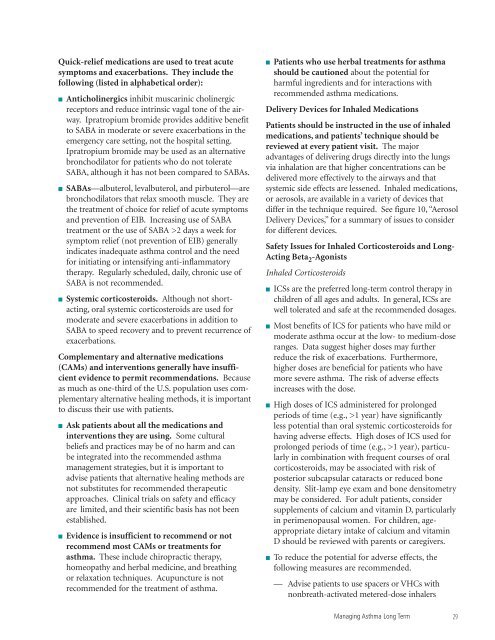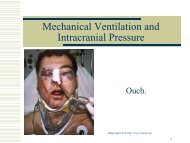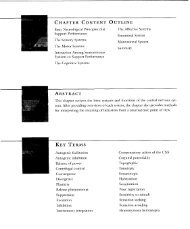Guidelines for the Diagnosis and Management of Asthma
Guidelines for the Diagnosis and Management of Asthma
Guidelines for the Diagnosis and Management of Asthma
You also want an ePaper? Increase the reach of your titles
YUMPU automatically turns print PDFs into web optimized ePapers that Google loves.
Quick-relief medications are used to treat acute<br />
symptoms <strong>and</strong> exacerbations. They include <strong>the</strong><br />
following (listed in alphabetical order):<br />
■ Anticholinergics inhibit muscarinic cholinergic<br />
receptors <strong>and</strong> reduce intrinsic vagal tone <strong>of</strong> <strong>the</strong> airway.<br />
Ipratropium bromide provides additive benefit<br />
to SABA in moderate or severe exacerbations in <strong>the</strong><br />
emergency care setting, not <strong>the</strong> hospital setting.<br />
Ipratropium bromide may be used as an alternative<br />
bronchodilator <strong>for</strong> patients who do not tolerate<br />
SABA, although it has not been compared to SABAs.<br />
■ SABAs—albuterol, levalbuterol, <strong>and</strong> pirbuterol—are<br />
bronchodilators that relax smooth muscle. They are<br />
<strong>the</strong> treatment <strong>of</strong> choice <strong>for</strong> relief <strong>of</strong> acute symptoms<br />
<strong>and</strong> prevention <strong>of</strong> EIB. Increasing use <strong>of</strong> SABA<br />
treatment or <strong>the</strong> use <strong>of</strong> SABA >2 days a week <strong>for</strong><br />
symptom relief (not prevention <strong>of</strong> EIB) generally<br />
indicates inadequate asthma control <strong>and</strong> <strong>the</strong> need<br />
<strong>for</strong> initiating or intensifying anti-inflammatory<br />
<strong>the</strong>rapy. Regularly scheduled, daily, chronic use <strong>of</strong><br />
SABA is not recommended.<br />
■ Systemic corticosteroids. Although not shortacting,<br />
oral systemic corticosteroids are used <strong>for</strong><br />
moderate <strong>and</strong> severe exacerbations in addition to<br />
SABA to speed recovery <strong>and</strong> to prevent recurrence <strong>of</strong><br />
exacerbations.<br />
Complementary <strong>and</strong> alternative medications<br />
(CAMs) <strong>and</strong> interventions generally have insufficient<br />
evidence to permit recommendations. Because<br />
as much as one-third <strong>of</strong> <strong>the</strong> U.S. population uses complementary<br />
alternative healing methods, it is important<br />
to discuss <strong>the</strong>ir use with patients.<br />
■ Ask patients about all <strong>the</strong> medications <strong>and</strong><br />
interventions <strong>the</strong>y are using. Some cultural<br />
beliefs <strong>and</strong> practices may be <strong>of</strong> no harm <strong>and</strong> can<br />
be integrated into <strong>the</strong> recommended asthma<br />
management strategies, but it is important to<br />
advise patients that alternative healing methods are<br />
not substitutes <strong>for</strong> recommended <strong>the</strong>rapeutic<br />
approaches. Clinical trials on safety <strong>and</strong> efficacy<br />
are limited, <strong>and</strong> <strong>the</strong>ir scientific basis has not been<br />
established.<br />
■ Evidence is insufficient to recommend or not<br />
recommend most CAMs or treatments <strong>for</strong><br />
asthma. These include chiropractic <strong>the</strong>rapy,<br />
homeopathy <strong>and</strong> herbal medicine, <strong>and</strong> breathing<br />
or relaxation techniques. Acupuncture is not<br />
recommended <strong>for</strong> <strong>the</strong> treatment <strong>of</strong> asthma.<br />
■ Patients who use herbal treatments <strong>for</strong> asthma<br />
should be cautioned about <strong>the</strong> potential <strong>for</strong><br />
harmful ingredients <strong>and</strong> <strong>for</strong> interactions with<br />
recommended asthma medications.<br />
Delivery Devices <strong>for</strong> Inhaled Medications<br />
Patients should be instructed in <strong>the</strong> use <strong>of</strong> inhaled<br />
medications, <strong>and</strong> patients’ technique should be<br />
reviewed at every patient visit. The major<br />
advantages <strong>of</strong> delivering drugs directly into <strong>the</strong> lungs<br />
via inhalation are that higher concentrations can be<br />
delivered more effectively to <strong>the</strong> airways <strong>and</strong> that<br />
systemic side effects are lessened. Inhaled medications,<br />
or aerosols, are available in a variety <strong>of</strong> devices that<br />
differ in <strong>the</strong> technique required. See figure 10, “Aerosol<br />
Delivery Devices,” <strong>for</strong> a summary <strong>of</strong> issues to consider<br />
<strong>for</strong> different devices.<br />
Safety Issues <strong>for</strong> Inhaled Corticosteroids <strong>and</strong> Long-<br />
Acting Beta 2 -Agonists<br />
Inhaled Corticosteroids<br />
■ ICSs are <strong>the</strong> preferred long-term control <strong>the</strong>rapy in<br />
children <strong>of</strong> all ages <strong>and</strong> adults. In general, ICSs are<br />
well tolerated <strong>and</strong> safe at <strong>the</strong> recommended dosages.<br />
■ Most benefits <strong>of</strong> ICS <strong>for</strong> patients who have mild or<br />
moderate asthma occur at <strong>the</strong> low- to medium-dose<br />
ranges. Data suggest higher doses may fur<strong>the</strong>r<br />
reduce <strong>the</strong> risk <strong>of</strong> exacerbations. Fur<strong>the</strong>rmore,<br />
higher doses are beneficial <strong>for</strong> patients who have<br />
more severe asthma. The risk <strong>of</strong> adverse effects<br />
increases with <strong>the</strong> dose.<br />
■ High doses <strong>of</strong> ICS administered <strong>for</strong> prolonged<br />
periods <strong>of</strong> time (e.g., >1 year) have significantly<br />
less potential than oral systemic corticosteroids <strong>for</strong><br />
having adverse effects. High doses <strong>of</strong> ICS used <strong>for</strong><br />
prolonged periods <strong>of</strong> time (e.g., >1 year), particularly<br />
in combination with frequent courses <strong>of</strong> oral<br />
corticosteroids, may be associated with risk <strong>of</strong><br />
posterior subcapsular cataracts or reduced bone<br />
density. Slit-lamp eye exam <strong>and</strong> bone densitometry<br />
may be considered. For adult patients, consider<br />
supplements <strong>of</strong> calcium <strong>and</strong> vitamin D, particularly<br />
in perimenopausal women. For children, ageappropriate<br />
dietary intake <strong>of</strong> calcium <strong>and</strong> vitamin<br />
D should be reviewed with parents or caregivers.<br />
■ To reduce <strong>the</strong> potential <strong>for</strong> adverse effects, <strong>the</strong><br />
following measures are recommended.<br />
— Advise patients to use spacers or VHCs with<br />
nonbreath-activated metered-dose inhalers<br />
Managing <strong>Asthma</strong> Long Term<br />
29





